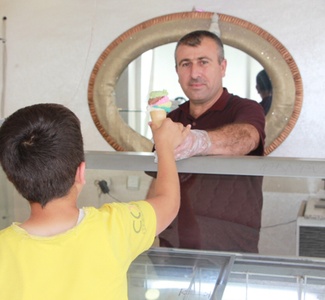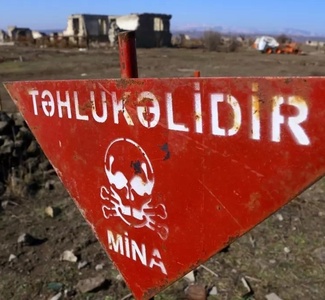Children constitute 26.5 percent of Türkiye's population
Türkiye’s population was 85 million 279 thousand 553 people by the end of 2022, 22 million 578 thousand 378 of it constituted by the child population, the Turkish Statistical Institute said in a statement on Tuesday.

 Google News'te Doğruhaber'e abone olun.
Google News'te Doğruhaber'e abone olun. 51.3% of child population was boys and 48.7% was girls. While the child population, which includes 0-17 age group according to the definition of United Nations, constituted 48.5% of the total population in 1970, this proportion was 41.8% in 1990 and 26.5% in 2022.
According to population projections the proportion of child population was expected to be 25.6% in 2030, 23.3% in 2040, 20.4% in 2060 and 19.0% in 2080.
Proportion of Türkiye child population was higher than that of the EU member countries
When the proportions of child population of 27 European Union (EU) member countries were analyzed, the EU average of the proportion of child population was 18.1% in 2022. Among the EU member countries, the countries with the highest proportion of child population were Ireland with 23.6%, France with 21.3%, Sweden with 21.0%, respectively. The countries with the lowest proportion of child population were Italy with 15.6%, Portugal with 15.8%, Malta with 15.9%, respectively. It was seen that the proportion of Türkiye child population with 26.5% was higher than that of the EU member countries.
The province with the highest proportion of child population was Şanlıurfa
According to ABPRS results when the proportion of child population in the total population was analyzed by provinces, the province with the highest proportion of child population was Şanlıurfa with 44.9% in 2022. Şanlıurfa was followed by Şırnak with 41.4% and Ağrı with 39.3%.
The province with the lowest proportion of child population was Tunceli with 16.9%. Tunceli was followed by Edirne with 17.7% and Kırklareli with 18.4%.
In Türkiye, the proportion of households with at least one child in the 0-17 age group was 44.3%
According to ABPRS results the total number of households in 2022 was 26 million 75 thousand 365. It was seen that the proportion of households with at least one child in the 0-17 age group was 44.3%. When the distribution of these households is examined by provinces, it was seen that the province with the highest proportion of households with at least one child in the 0-17 age group was Şanlıurfa with 70.3% and the province with the lowest proportion was Tunceli with 29.0%.
It was seen that 18.9% of total households had one child in the 0-17 age group, 15.4% of them had two children, 6.5% of them had three children, 2.2% of them had four children, 1.3% of them had five and more children.
It was seen that 29.4% of the child population was in the 5-9 age group in 2022
When the child population was examined by age group, while 28.3% of the child population was in the 0-4 age group, 27.7% in the 5-9 age group, 27.1% in the 10-14 age group and 16.8% in the 15-17 age group in 2017, 25.1% was in the 0-4 age group, 29.4% was in the 5-9 age group, 28.5% was in the 10-14 age group and 17.0% in the 15-17 age group in 2022.
The number of babies born alive was 1 million 79 thousand 842 in 2021
According to birth statistics the number of babies born alive in 2021 was 1 million 79 thousand 842. 554 thousand 41 of them were boys, and 525 thousand 801 of them were girls. 96.9% of the babies born alive were single births, 3.0% were twins, and 0.1% were triplets or more.
According to the data of the Ministry of Health while the proportion of births in hospitals was 91.6% in 2010, it was 97.5% in 2021.
The most popular names given to babies were Alparslan for boys and Zeynep for girls
According to the results of ABPRS the most popular names given to newborn baby boys were Alparslan, Yusuf and Miraç, the most popular girl names were Zeynep, Asel and Defne in 2022. It was seen that 8 thousand 332 of the newborn boys were named Alparslan, 6 thousand 370 of them were named Yusuf, 5 thousand 43 of them were named Miraç; 8 thousand 876 of the newborn girls were named Zeynep, 6 thousand 845 of them were named Asel, 6 thousand 830 of them were named Defne.
In Türkiye, it was seen that the most popular boy names were Yusuf, Mustafa and Mehmet, the most popular girl names were Zeynep, Elif and Yağmur for the children in 0-17 age group in 2022.
Child dependency ratio was 32.3% in 2022
Total age dependency ratio is defined as the total number of persons at 0-14 and persons at 65 and over age groups per 100 persons at 15-64 age group in working age. According to the results of ABPRS, total age dependency ratio was 46.8% in 2022. The child dependency ratio means that the number of children at the 0-14 age group per 100 persons at 15-64 age group was 32.3%.
Net enrollment rate of five-year-olds was 81.6%
According to the formal education statistics of the Ministry of National Education while the net enrollment rate of five-year-olds was 56.9% in the 2020/'21 educational year, it was 81.6% in the 2021/'22 educational year. When the net enrollment rate of five-year-olds was analyzed by sex, this rate was 81.9% for boys and 81.4% for girls.
Net enrollment rate at primary school level was 93.2%, net enrolment rate at lower secondary school level was 89.8% and net enrollment rate at upper secondary school level was 89.7% in the 2021/'22 educational year.
School completion rates at levels of education increased
According to the National Education Statistics Database results when school completion rates by levels of education and sex were examined, an increase was observed over the years. While primary school completion rate was 98.3% in the 2016/'17 educational year, it was 98.4% in the 2021/'22 educational year. While lower secondary school completion rate was 88.9% in the 2016/'17 educational year, it was 96.4% in the 2021/'22 educational year. Upper secondary education completion rate was increased from 62.9% to 77.9%.
When upper secondary education completion rate was analyzed by sex, it was seen that upper secondary education completion rate was 76.2% for boys and 79.6% for girls in the 2021/'22 educational year.
The proportion of children aged 3-17 who brush their teeth at least once a day was 66.5%
According to Türkiye child survey results the proportion of children aged 3-17 who brush their teeth at least once a day was 66.5% which was stated by their mothers/primary caregivers. While the proportion of girls in the 3-17 age group who was stated as they brush their teeth at least once a day was 73.4%, the proportion of boys was 60.0%.
When tooth brushing proportions were analyzed by age groups, it was seen that the proportion of children brushing their teeth increased with age. While the proportion of children in the 3-5 age group which was stated as they brush their teeth at least once a day was 52.1%, the proportion of children in the 13-17 age group was 75.9%.
The proportion of children aged 5-17 who had difficulty concentrating was 1.4%
According to Türkiye child survey results when the children who have great difficulty or who cannot do it at all in the relevant functional domain were examined, the proportion of children in the 5-17 age group who were reported to have difficulty seeing was 1.0%, the proportion of children in the same age group who were reported to have difficulty in hearing was 0.2%, and the proportion of children in the same age group who were reported to have difficulty in walking was 1.1% and the proportion of children who have difficulty in self-care was 0.9% which was stated by their mothers/primary caregivers.
In the 5-17 age group children, the proportion of children who were reported to have difficulties in communicating was 0.8%, in learning was 1.5%, in remembering was 1.1%, in concentrating was 1.4% which was stated by their mothers/primary caregivers. The proportion of children who were reported to have difficulties in accepting the change was 2.1%, in controlling behaviour was 1.6% and in making friends was 2.1% which was stated by their mothers/primary caregivers.
While the proportion of children in the 5-17 age group who was experiencing anxiety every day was 7.3%, the proportion of children in the same age group who was feeling depressed every day was 4.7% which was stated by their mothers/primary caregivers.
The proportion of children aged 6-17 who felt under the pressure of school lessons was 13.4%
According to Türkiye child survey results the proportion of children aged 6-17 who felt under the pressure of school lessons was 13.4% which was stated by their mothers/primary caregivers. While the proportion of boys in the 6-17 age group which was stated that they felt under the pressure of school lessons was 12.7%, the proportion of girls in the same age group was 14.1%.
It was seen that the highest proportion of feeling under the pressure of school lessons was in the 15-17 age group with 14.3%. It was seen that the proportion of children in the 6-9 age group which was stated that they felt under the pressure of school lessons was 12.1%, the proportion of children in the 10-12 age group was 14.0%, and the proportion of children in the 13-14 age group was 13.8%.
The proportion of children aged 6-17 who were bullied by other children was 13
According to Türkiye child survey results the proportion of children aged 6-17 who were bullied by other children at least a few times a month was 13.8%, which was stated by their mothers/primary caregivers.
While the proportion of children in the 6-17 age group who were made fun of by their peers at least a few times a month was 7.7% which was stated by their mothers/primary caregivers, the proportion of the children in the same age group who were left out of things on purpose by their peers at least a few times a month was 7.2%.
The proportion of children aged 13-17 who stated that they felt left out of things at school was 6.8%
According to Türkiye child survey results while the proportion of children aged 13-17 who stated that they could easily make friends at school was 73.2%, the proportion of children in the same age group who felt that they belonged to the school was 72.4%. The proportion of children who stated that other students seemed to like them was 55.6%, the proportion of children aged 13-17 who stated that they felt awkward and out of place at school was 8.8%, the proportion of children who stated that they felt like an outsider (or left out of things) and the proportion of children who felt lonely at school was 6.8%.
The proportion of children aged 13-17 who stated that they felt very anxious even if they were well prepared for the exam was 50.5%. While this proportion was 43.9% for boys in the same age group, it was 57.6% for girls.
The proportion of children who stated that they felt happy or moderately happy was 96.7%
According to Türkiye child survey results while the proportion of children in the 13-17 age group who stated that they felt happy throughout their lives was 69.1%, the proportion of children in the same age group who felt moderately happy was 27.6%, and the proportion of those who felt unhappy was 3.4%.
While the proportion of boys in the 13-17 age group who stated that they felt happy was 71.4%, the proportion of boys in the same age group who felt moderately happy was 25.6%, and the proportion of those who felt unhappy was 2.9%.
While the proportion of girls in the 13-17 age group who stated that they felt happy was 66.5%, the proportion of girls in the same age group who felt moderately happy was 29.6%, and the proportion of those who felt unhappy was 3.9%.
The proportion of children aged 13-17 who stated that they knew the Convention on the Rights of the Child was 45.1%
According to Türkiye child survey results it was seen that the proportion of children aged 13-17 who stated that they knew the Convention on the Rights of the Child was 45.1%. While this proportion was 39.1% for boys in the same age group, it was 51.4% for girls.
While the proportion of children aged 13-17 who knew which rights children had was 53.3%, the proportion of children who think that adults generally respected rights of the children was 52.7%.
Legal child marriages for girls decreased
According to marriage statistics while the proportion of legal child marriages for girls aged 16-17 within the total legal marriages was 7.3% in 2002, it decreased to 2.0% in 2022. On the other hand, while the proportion of legal child marriages for boys at the same ages in the total legal marriages was 0.5% in 2002, it was 0.1% in 2022.
The labor force participation rate for children at the age group of 15-17 was 18.7%
According to the results of Household Labor Force Survey 2022 the labor force participation rate at the age group of 15-17 was 18.7%. When the labor force participation rate was analyzed by sex, it was seen that this rate was 27.0% for boys, and 10.0% for girls.
The number of children whose fathers died was 266 thousand 532
According to the results of ABPRS it was seen that the number of children whose fathers died was 266 thousand 532, the number of children whose mothers died was 81 thousand 420, the number of children whose parents died was 4 thousand 219 within total 22 million 578 thousand 378 children in 2022.
The number of children who were cared for by foster families was 9 thousand 11
According to the data of the Ministry of Family and Social Services it was seen that the number of children in institutional care was 14 thousand 141 in Türkiye in 2022. The number of foster families in total was 7 thousand 439, and the number of children with foster parents was 9 thousand 11. The number of adopted children was 556 in 2022.
The proportion of children given to mother's guardianship was 75.7%
According to divorce statistics the number of couples divorced in 2022 was 180 thousand 954. As a result of the finalized divorce cases, 180 thousand 592 children were given custody. It was observed that 75.7% of the custody of the children was given to the mother, and 24.3% to the father.
Children died mostly as a result of external injuries and poisoning
According to death and causes of death statistics the highest number of child deaths at the age group of 1-17 was occurred due to external injures and poisoning in 2021. The number of child at the age group of 1-17 who died due to this reason was one thousand 313 in 2021. 893 children died due to diseases of the nervous system and the sense organs, 669 children due to neoplasms, 429 children circulatory system diseases.
Infant mortality rate was 9.2 per thousand
According to death and causes of death statistics while the infant mortality rate was 13.9 per thousand in 2009, it decreased to 9.2 per thousand in 2021. When the infant mortality rate was examined by sex, it was seen that the infant mortality rate decreased from 14.6 per thousand to 9.8 per thousand for boys, and it decreased from 13.1 per thousand to 8.6 per thousand for girls between the years of 2009 and 2021.
While the under-five mortality rate which is the probability of dying during five years after birth, was 17.7 per thousand in 2009, it decreased to 11.2 per thousand in 2021. When the under-five mortality rate was examined by sex, it was seen that the under-five mortality rate decreased from 18.5 per thousand to 11.9 per thousand for boys, and it decreased from 16.8 per thousand to 10.5 per thousand for girls between the years of 2009 and 2021. (ILKHA)



















































